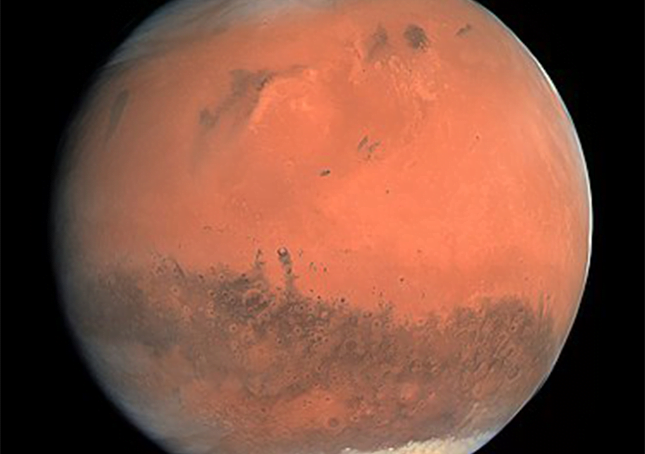Climate of Mars

The climate of Mars has been a topic of scientific curiosity for centuries, in part because it is the only terrestrial planet whose surface can be directly observed in detail from the Earth with help from a telescope.
Although Mars is smaller than the Earth, 11% of Earth’s mass, and 50% farther from the Sun than the Earth, its climate has important similarities, such as the presence of polar ice caps, seasonal changes and observable weather patterns. It has attracted sustained study from planetologists and climatologists. While Mars’ climate has similarities to Earth’s, including periodic ice ages, there are also important differences, such as much lower thermal inertia.
Mars’ atmosphere has a scale height of approximately 11 km (36,000 ft), 60% greater than that on Earth. The climate is of considerable relevance to the question of whether life is or ever has been present on the planet. The climate briefly received more interest in the news due to NASA measurements indicating increased sublimation of one near-polar region leading to some popular press speculation that Mars was undergoing a parallel bout of global warming,[1] although Mars’ average temperature has actually cooled in recent decades, and the polar caps themselves are growing.
Mars has been studied by Earth-based instruments since the 17th century, but it is only since the exploration of Mars began in the mid-1960s that close-range observation has been possible. Flyby and orbital spacecraft have provided data from above, while landers and rovers have measured atmospheric conditions directly. Advanced Earth-orbital instruments today continue to provide some useful “big picture” observations of relatively large weather phenomena.
The first Martian flyby mission was Mariner 4, which arrived in 1965. That quick two-day pass (July 14–15, 1965) with crude instruments contributed little to the state of knowledge of Martian climate.
Later Mariner missions (Mariner 6, and Mariner 7) filled in some of the gaps in basic climate information. Data-based climate studies started in earnest with the Viking program landers in 1975 and continue with such probes as the Mars Reconnaissance Orbiter.
This observational work has been complemented by a type of scientific computer simulation called the Mars general circulation model.[2] Several different iterations of MGCM have led to an increased understanding of Mars as well as the limits of such models.
